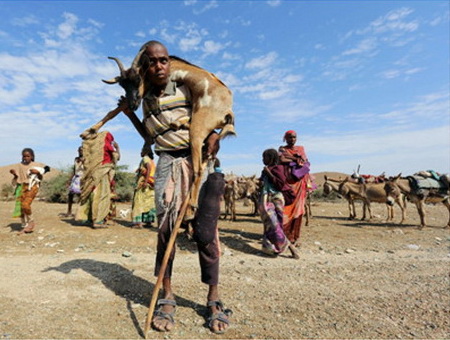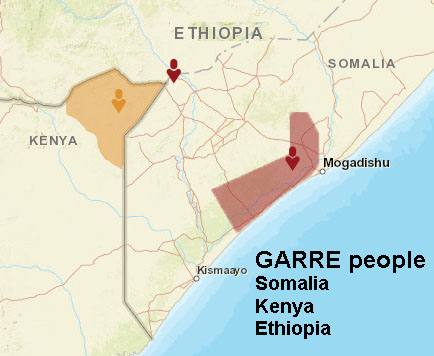

The Garre are a Somali pastoralist clan genealogically belonging to the Digil Clans of Rahaweyn the Garre live in southern Somalia, northeastern Kenya and southern Ethiopia. The Garre of Somalia are a sub-tribe of a much larger ethnic group known as the Somali. Almost all Garre people speak the Maay Maay language as well as specific Garre language, which is an East Omo-Tana that is taxonomically a distinct language (closely related to the Aweer language) but sociologically perceived as a dialect of Somali by both the Garre themselves and neighboring clans whom speak Somali. |
 |
Garre clans use three languages to communicate among themselves, including the common Somali; the Rahanwein dialect of Southern Somalia, and the ‘Garre’ language of Mandera, which is a Somalised dialect of Borana. Their urban centers include Mandera, El Wak, Moyale, Takaba, Banissa, Wargadud, Rhamu and Kutulo. A substantial number of Garre people are also found in major cities of Kenya such as Nairobi, Mombasa and Kisumu.
In Southern Somalia, they live in Kofur near Mogadishu and Lower Shabelle Afgooye, Waanlaweyn, Qoronyoley, Merca, and Awdhagle Districts, and El Wak District in Gedo, Jubaland. In Ethiopia, they live in Moyale, Hudet, Mubarak, Qadaduma, Suruba, Raaro, Lehey and Woreda of Dawa zone. In Kenya, the Garre inhabit Mandera County, Wajir, North Moyale, as well as part of Isiolo County.
The largest population and composition of Garres live in Mandera County, making them the single largest clan in Mandera County. They are largely in Kenya and Ethiopia. The Garre claim descent from Samaale although they fall under the Rahanweyn politically in the borders of Somalia as sub-clan of the Digil clan due to isolation from other Garre's, but because Garre are camel keeping nomands and not farmers they do not claim descend from them.
The Garre are divided into the Tuff and Quranyow sub-clans. While the Tuffs are further divided into the Ali and Adola groups, the Quranyow are divided into the Asare and Furkesha.
In history, Identities on the Move: Clanship and Pastoralism in Northern Kenya, by Gunther Schlee, Voice and Power, by Hayward and UNDP Paper on Kenya, the Garre are divided into the following clans. The Garre split in 2 great sub-clans, Tuf and Kuranyo. The Kuranyo are Garre by marriage. Kuranyow who married Tuf's daughter Mako, became part of the Garre confederation.
Most Garre are nomadic herdsmen, seasonally migrating with their camels, sheep, and goats. They live in portable huts made of bent saplings covered with animal skins or woven mats. Their collapsible tents can easily be loaded on pack animals and moved with the herds. The wealth of most Garre is in their herds. Although the husband remains the legal owner of the herd, his wife controls part of it.
Garre villages consist of several related families. Their huts are arranged in a circle or semi-circle surrounding the cattle pens. Villages are enclosed by thorn-shrub hedges to provide protection from intruders or wild animals. The men's responsibilities include caring for the herds, making decisions dealing with migration, and trading. The women are in charge of domestic duties, such as preparing the meals, milking the animals, caring for the children, and actually building the home. Like other nomads, the Garre scorn those who work with their hands, considering craftsmen a part of the lower class.
The moving patterns of Garre nomads are dependent upon climate and the availability of grazing land. If water or grazing land becomes scarce, the families pack up their portable huts and move across the desert as a single, extended family unit. The Garre are quite loyal to one another, spreading evenly across the land to make sure that everyone has enough water and pasture for his herds.
According to Islamic law, a man may have as many as four wives. Each wife has her own hut where she raises her children. Unfortunately, the divorce rate among the Garre is high. The children of divorced parents are usually split by gender, with the wife taking the girls and the husband taking the boys.
Formerly, the Garre's diet consisted of almost solely dairy products. Today, however, maize, rice, and some vegetables are also included. Chewing qat, a mild stimulant, is a favorite social pastime for most Garre.
The Somali tribes were converted to Islam in the 1400s, and today, the Garre are virtually all Muslim. Some Garre believe that they descended from Arab Muslims; however, linguistic research disproves this theory. Although they are quite orthodox in their religious practices, few have a deep understanding of Islam.
Sources: